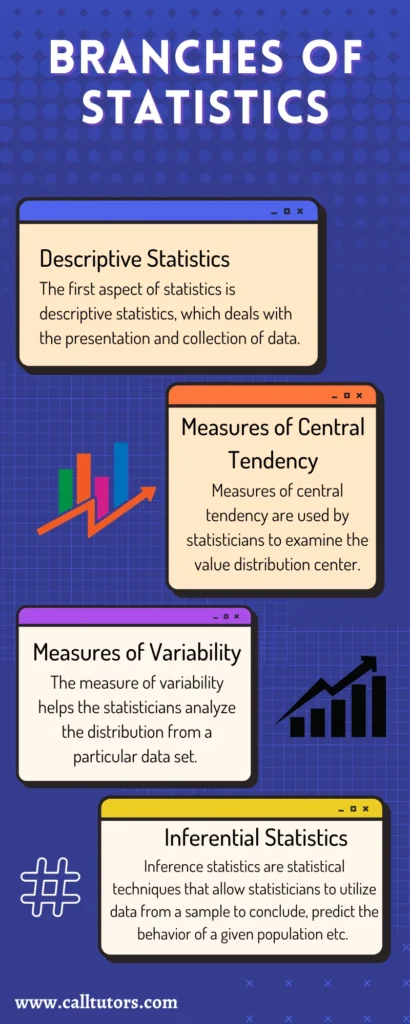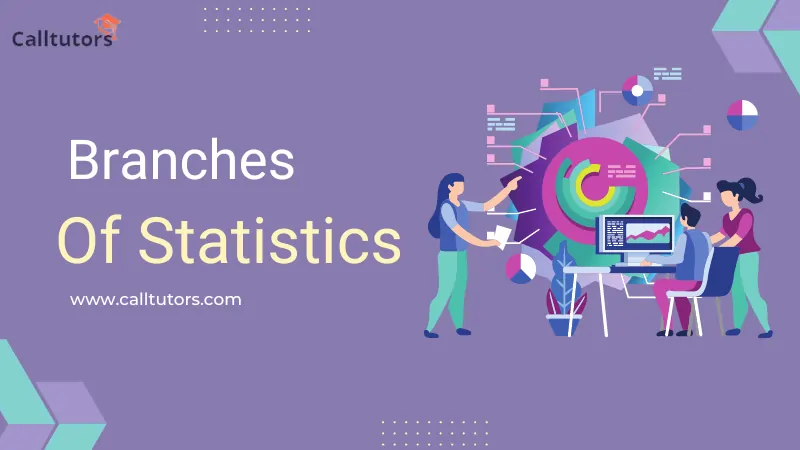Statistics is a branch of mathematics that deals with data collection, analysis, interpretation, presentation, and organization. It is a crucial tool for making informed decisions in various fields such as business, medicine, social sciences, and natural sciences. Over the years, statistics have evolved and branched into several subfields.
There are two main branches of statistics that are Descriptive Statistics and Inferential Statistics. We are aware that many students are already familiar with statistics branches. To clear up any confusion, we will thoroughly explore both Branches of statistics in this blog. Before diving into the areas of statistics, let us read about statistics.
What is Statistics?
Table of Contents
The most important branch of mathematics is statistics. It is used to accomplish various tasks, such as data collecting, organization, and analysis. Or we can say that statistics is a type of mathematical analysis that uses quantitative models to generate experimental data or real-world studies. Statistics explores the methods for gathering, examining, interpreting, and drawing conclusions from data. The following are some statistical measures:
- Mean
- Variance
- Skewness
- Regression analysis
- Kurtosis
- Analysis of variance
- Descriptive Statistics
Key Takeaways
- Statistics is the study and the manipulation of the data, including methods for data collecting, organization, analysis and conclusion.
- Descriptive and inferential statistics are the two main areas of statistics.
- Business and investment decisions can improve with the use of statistics.
Branches of Statistics
Descriptive statistics and inferential statistics are the two main branches of statistics. Both the statistics branches are used in scientific data analysis and are equally significant for a statistics student.

Descriptive Statistics
The first aspect of statistics is descriptive statistics, which deals with the presentation and collection of data. It is not as simple as it appears. The statistician must know how to design and experiment, select the appropriate focus group, and prevent biases that are too easy to introduce into the experiment.
Generally, descriptive statistics can be categorized into
- Measures of central tendency
- Measures of variability
To understand both measures of tendency and variability, easily use graphs, tables, and general discussions.
Measures of Central Tendency
Measures of central tendency are used by statisticians to examine the value distribution center. These are the measures of tendency:
Mean
A mean is a common approach for describing the central tendency. To calculate the average of several values, count them all and divide them by the number of possible values.
Median
It is an outcome found in the middle of a set of values. In numerical journals, edit the results, and the result that is in the center of the distributed sample finds that one is an easy technique to get the median.
Mode
In the given data set, the value which occurs most frequently is the mode.
Measures of Variability
The measure of variability helps the statisticians analyze the distribution from a particular data set. Quartiles, ranges, variances, and standard deviations are the variability variables.
Inferential Statistics
Inference statistics (statistics branch) are statistical techniques that allow statisticians to utilize data from a sample to conclude, predict the behavior of a given population, and make judgments or decisions.
Using descriptive statistics, inference statistics frequently talk in terms of probability. Furthermore, a statistician uses these techniques mainly for data analysis, writing, and drawing conclusions from the limited data. This is accomplished by taking samples and determining their reliability.
Most future predictions and generalizations based on a population study of a smaller specimen are covered by inference statistics. Furthermore, the majority of social science experiments involve the investigation of a small sample population, and that helps in determining community behavior.
The researchers can bring the study-related conclusions by designing a practical experiment. When drawing conclusions, it is important to avoid drawing incorrect or biased conclusions.
There are some different types of inferential statistics, which include the following, which are shown below:
- Regression analysis
- Analysis of variance (ANOVA)
- Analysis of covariance (ANCOVA)
- Statistical significance (t-test)
- Correlation analysis
Conclusion (Branches of Statistics)
It is all about the branches of statistics. Now, you should have a better idea about the areas of statistics or statistics branches. We hope this blog was helpful to you and you understood it completely. But if, in any case, you are facing any kind of trouble and want our help with statistics homework, then you are in the right place. Our experts provide you with the best service. You can contact us any time. We are 24*7 available here to help you.
Also, Read..!!
Difference Between Descriptive and Inferential Statistics
FAQs (Frequently Asked Questions)
What are the two main branches of statistics?
The two branches of statistics which are the main one are descriptive statistics and inferential statistics.
Who uses statistics?
Statistics are commonly used in a variety of applications and professions. Statistics are managed to create whenever data is collected and examined. This can include everything from government organizations to academic research to analyzing investments.
What is the difference between descriptive and inferential statistics?
The features or qualities of a data set are summarised by using descriptive statistics. You can use inferential statistics to test a hypothesis or see if your data is generalizable to a larger population.



